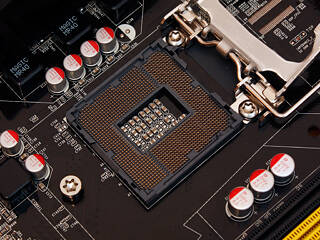 22
22
Foxconn P67A-S Intel P67 Preview Review
Value & Conclusion »A Closer Look
The socket looks very much like the 1156 parts with two seperated pin "chambers" and the holes for a CPU cooler are placed in the exact same locations so that you can keep using your existing cooler if it is compatible to Socket 1156 already. The P67 chipset is rather compact and has a laser engraving with various information on there. Foxconn uses thermal tape to transfer the heat from the chipset to the small heatsink. I count five phases for the CPU, which should suffice for most applications.
A little display can show you where the board gets stuck during the boot process with the help of various POST codes. This should make troubleshooting on the Foxconn board much easier and it is good to see such a feature on this unit. Interestingly enough you also have voltage measuring points on the left edge of the board. Such a feature is usually reserved for high-end mainboards and it is interesting to see such a possibility on a board like this.
Foxconn has implemented an AMIBIOS unto the board. Foxconn has also been using that configuration with the Bloodrage X58 boards already.
We can see Foxconn's proprietary chip labeld "FOX 2" located close to the CPU socket. This chip has been around for quite some time - years even. In the past the Fox One has been used to implement overclocking features or control the fan speeds.
Since P67 does not support PCI, a IDT PCIe to PCI bridge chip is used to enable the two PCI slots on the motherboard. Besides that you will find the D720200F1 USB 3.0 controller chip from NEC as Intel has refused to incorporate this new interface into their P67 chipsets.
There is a small IC to the north of the CPU socket. I am not sure what this one is for. It is extremely tiny and I can only read the letters "ON".
A Marvel 88SE6121 chip is used to offer the dual eSATA connectivity along with an IDE port. While it is a good feature to have - just in case, this interface is on the way out.
Both Audio and the Gigabit Ethernet are provided by Realtek chips. The first is an ALC888, a very common 7.1 audio controller, while the other is the RLT8111E.
Jul 1st, 2025 03:05 CDT
change timezone
Latest GPU Drivers
New Forum Posts
- Recommend me a decent budget card :) (16)
- Will you buy a RTX 5090? (585)
- Do you use Linux? (666)
- Super-slow WiFi (2)
- R-T-B's PNY RTX 5080 OC Photo sideshow. (1)
- Question about Intel Optane SSDs (88)
- The Official Thermal Interface Material thread (1756)
- Your PC ATM (35476)
- Help with a gtx1050 mxm (1)
- [Request] GTX 1650 mobile DEV_1F99 SUBSYS_143E1025 VBIOS firmware (0)
Popular Reviews
- ASUS ROG Crosshair X870E Extreme Review
- Sapphire Radeon RX 9060 XT Pulse OC 16 GB Review - An Excellent Choice
- AVerMedia CamStream 4K Review
- Lexar NQ780 4 TB Review
- AMD Ryzen 7 9800X3D Review - The Best Gaming Processor
- Upcoming Hardware Launches 2025 (Updated May 2025)
- Sapphire Radeon RX 9070 XT Nitro+ Review - Beating NVIDIA
- AMD Ryzen 9 9950X3D Review - Great for Gaming and Productivity
- NVIDIA GeForce RTX 5060 8 GB Review
- Intel Core Ultra 7 265K Review
TPU on YouTube
Controversial News Posts
- Intel's Core Ultra 7 265K and 265KF CPUs Dip Below $250 (288)
- NVIDIA Grabs Market Share, AMD Loses Ground, and Intel Disappears in Latest dGPU Update (204)
- Some Intel Nova Lake CPUs Rumored to Challenge AMD's 3D V-Cache in Desktop Gaming (140)
- NVIDIA Launches GeForce RTX 5050 for Desktops and Laptops, Starts at $249 (105)
- Microsoft Partners with AMD for Next-gen Xbox Hardware (105)
- Intel "Nova Lake‑S" Series: Seven SKUs, Up to 52 Cores and 150 W TDP (100)
- NVIDIA GeForce RTX 5080 SUPER Could Feature 24 GB Memory, Increased Power Limits (97)
- Reviewers Bemused by Restrictive Sampling of RX 9060 XT 8 GB Cards (88)












